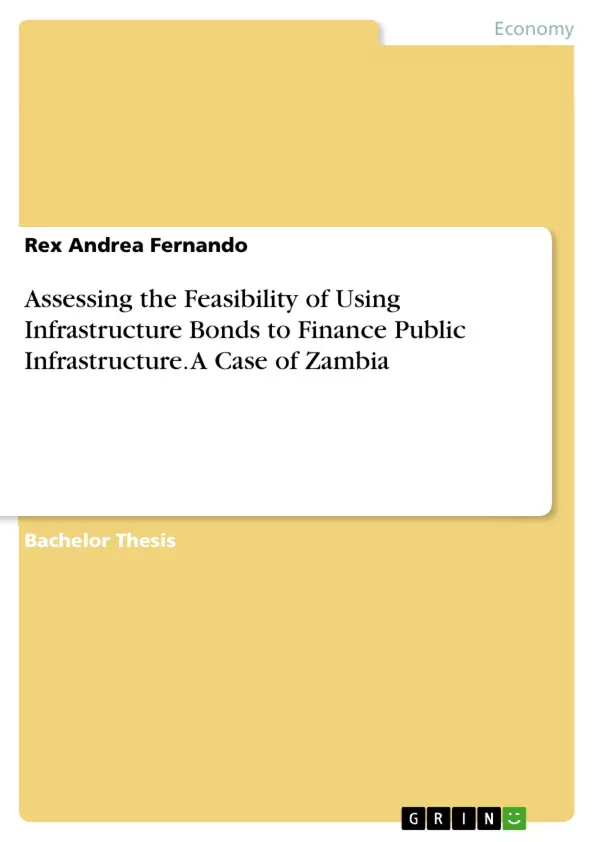The aim of this study stands out to be a solution to the current trends of poor financial backing by the government on public funded project. This aim was achieved through delving into the concept of Infrastructure bonds as well as the requirement for applying for this type of bond.
The use of a detailed literature review and a questionnaire survey as well as interviews, provided the results of this study by highlighting the fact that Infrastructure bonds are not feasible to finance public Infrastructure in Zambia at the moment. This study underscored the financial gap that exists at present in Zambians Public Sector with reference to Infrastructure Development. Additionally, the key requirement for applying for Infrastructure bonds were a scrutiny of, namely: Structural features; Macro-economic factors; Public finance; External finance; Contractual framework; and Risk management techniques. The study also identified countries that have accessed these bonds and this was achieved through the use of case studies such as those of Kenya in Africa and Belgium and Spain in Europe.
The study identified that although, Infrastructure bonds are not feasible at the moment, the most favorable bonds to be used if all the necessary logistics are put in place are the Informed bonds. Therefore, these bonds are a remedy to Zambia’s current financial challenges with regards to Public Infrastructure as well as to contain the unethical practices prevalent on public funded projects.
Inhaltsverzeichnis (Table of Contents)
- CHAPTER ONE
- 1.1 INTRODUCTION
- 1.2 PROBLEM JUSTIFICATION
- 1.3 PROBLEM STATEMENT
- 1.4 PROPOSITION
- 1.5 IMPORTANCE OF THE STUDY
- 1.6 OBJECTIVES
- 1.7 METHODS OF DATA COLLECTION
- 1.7.1 Primary Data
- 1.7.2 Secondary Data
- 1.8 SCOPE OF THE STUDY
- 1.9 LIMITATION TO THE STUDY
- 1.10 CHAPTER LAYOUT
- CHAPTER TWO
- 2.1 INTRODUCTION
- 2.2 INFRASTRUCTURE
- 2.2.1 Institutional Infrastructure
- 2.2.2 Personal Infrastructure
- 2.2.3 Material Infrastructure
- 2.3 INFRASTRUCTURE FINANCING
- 2.3.1 Public Sector Participation
- 2.3.2 Private Sector Participation
- 2.3.3 Equity Finance
- 2.3.4 Debt Finance
- 2.4 FINANCIAL GAP IN INFRASTRUCTURE FINANCING IN ZAMBIA
- 2.5 BONDS
Zielsetzung und Themenschwerpunkte (Objectives and Key Themes)
This thesis examines the feasibility of using infrastructure bonds to finance public infrastructure in Zambia. It explores the current state of infrastructure financing in Zambia, highlighting the challenges and opportunities presented by the use of infrastructure bonds. The research aims to determine whether infrastructure bonds can be a viable solution for bridging the financing gap and promoting sustainable infrastructure development in the country.
- Infrastructure financing in Zambia
- Feasibility of infrastructure bonds
- Challenges and opportunities of infrastructure bonds
- Impact of infrastructure bonds on sustainable development
- Policy recommendations for promoting infrastructure bonds
Zusammenfassung der Kapitel (Chapter Summaries)
Chapter One provides an introduction to the research topic, outlining the problem justification, statement, proposition, importance, and objectives of the study. It also details the methods of data collection, scope, limitations, and chapter layout.
Chapter Two delves into the concept of infrastructure, covering its various types, including institutional, personal, and material infrastructure. The chapter further explores infrastructure financing mechanisms, emphasizing both public and private sector participation, equity financing, and debt financing. It also analyzes the financial gap in infrastructure financing in Zambia and provides an overview of bonds as a potential financing instrument.
Schlüsselwörter (Keywords)
This research focuses on infrastructure financing, infrastructure bonds, public infrastructure, financial gap, sustainable development, policy recommendations, Zambia, and debt financing.
- Citar trabajo
- Rex Andrea Fernando (Autor), 2018, Assessing the Feasibility of Using Infrastructure Bonds to Finance Public Infrastructure. A Case of Zambia, Múnich, GRIN Verlag, https://www.grin.com/document/463134



